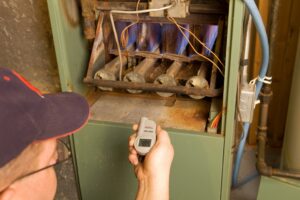Having a gas furnace is a huge benefit to your home. Gas furnaces provide heat quickly and effectively. But you do face some risks with a gas furnace because there’s always a chance of a carbon monoxide leak. The good news is, modern furnaces have a lot of safety features on them.
You can keep reading to learn more about the safety features on gas furnaces. If you have an older furnace that doesn’t include these safety features, it may be time for an upgrade. No matter what type of heater you have, you can give our team a call for furnace repair in Portland, OR if you have any concerns about how your furnace is operating or just want to schedule a tune-up.
Flame Sensor
Your gas furnace provides heat by releasing gas into the chamber where the pilot light is located. Once gas releases, the pilot light ignites to create heat which gets transferred into air and blown into your home. You don’t want that flame to be on unless there is gas in the chamber.
If the flame burns for longer than is needed, it creates fire hazards to your home as well as wearing down the igniter faster. The flame sensor ensures that the flame is only on when there is gas in the chamber during a heating cycle.
Flue Exhaust Pressure Sensor
Your heater also has a flue exhaust pressure sensor. In the heat exchanger, clean, warm air is blowing into your home in one direction, while exhaust is exiting your home in another direction. These two streams of air should never mix. However, it’s possible for flue build-up to cause blockages in the system that allow exhaust to mix in with clean air.
The flue exhaust pressure sensor is in place to sense when this happens and shut your furnace down so that exhaust air cannot mix in with clean air that blows into your home. If your heater turns off quickly after beginning a heating cycle, this may be why. Without staying on for a complete heating cycle your home will never get as warm as you expect.
Limit Switch
Another safety feature on your gas furnace is the limit switch. There are a variety of reasons that your gas furnace could overheat. When it comes to keeping your home warm there is hot, and then there is too hot. And if your furnace gets too hot, it poses a variety of risks to the system itself as well as your home and family. The limit switch identifies when the temperature inside of your furnace gets too high.
It triggers for your furnace to turn off and cool down as a safety precaution. Keep in mind that your furnace may continue to turn on for heating cycles, although if it keeps overheating, it will Keep turning off before completing a heating cycle all the way through. This is a red flag that something is wrong with your furnace and needs to be addressed.
Please call Sydni, our Office Extraordinaire, to schedule your next appointment! The Clean Air Act team will take care of you from there!


Join Us Online